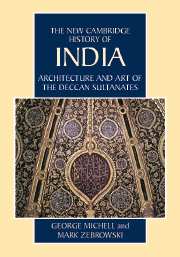Book contents
- Frontmatter
- Introduction
- 1 Historical framework
- 2 Forts and palaces
- 3 Mosques and tombs
- 4 Architectural decoration
- 5 Miniature painting: Ahmadnagar and Bijapur
- 6 Miniature painting: Golconda and other centres
- 7 Textiles, metalwork and stone objects
- 8 Temples
- 9 Conclusion
- Appendix: Dynastic Lists of Deccan Rulers
- Bibliographic Essay
- Bibliography
- Index
- Map of the Southern Deccan"
- Plate Section"
4 - Architectural decoration
Published online by Cambridge University Press: 28 March 2008
- Frontmatter
- Introduction
- 1 Historical framework
- 2 Forts and palaces
- 3 Mosques and tombs
- 4 Architectural decoration
- 5 Miniature painting: Ahmadnagar and Bijapur
- 6 Miniature painting: Golconda and other centres
- 7 Textiles, metalwork and stone objects
- 8 Temples
- 9 Conclusion
- Appendix: Dynastic Lists of Deccan Rulers
- Bibliographic Essay
- Bibliography
- Index
- Map of the Southern Deccan"
- Plate Section"
Summary
All the phases of Deccani architecture surveyed in this volume are characterised by richly adorned surfaces. Incised plaster appears to have been the preferred material for decoration in Bahmani buildings during the fourteenth and fifteenth centuries, continued in later times under the Baridis and Qutb Shahis. This material was replaced to some extent by stone as a primary decorative medium in the sixteenth and seventeenth centuries, as in the mosques and tombs of the Nizam Shahis and Adil Shahis. Carved wood and coloured tiles were probably in widespread use throughout these centuries, but only fragmentary evidence has survived; sadly, the painted heritage is similarly incomplete. This situation changes to some extent in the eighteenth century from which time there are Maratha-style mansions furnished with woodwork and murals.
The repertory of ornamental themes in all materials is at first limited, with a preference for geometric and stylised floral motifs inherited from Khalji and Tughluq architecture. That indigenous traditions gradually manifest themselves is evident in the widespread use of naturalistic motifs based on the lotus and other plant forms. The impact of Iranian and even occasionally Turkish traditions detected in later Bahmani and in Nizam Shahi buildings is accompanied by a new range of motifs, especially calligraphy, stylised plant forms and dense arabesque patterns. The most spectacular instance of an imported decorative scheme is the tilework on the madrasa of Mahmud Gawan at Bidar. Architectural ornament in carved stone at Bijapur attains a degree of exuberance unmatched elsewhere. Designs based on animal and vegetal motifs become popular, though always in partnership with calligraphic, arabesque and geometric patterns, reflecting the sustained impact of Islamic artistic conventions.
Keywords
- Type
- Chapter
- Information
- Architecture and Art of the Deccan Sultanates , pp. 115 - 144Publisher: Cambridge University PressPrint publication year: 1999



